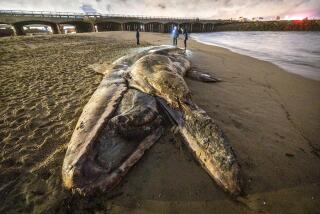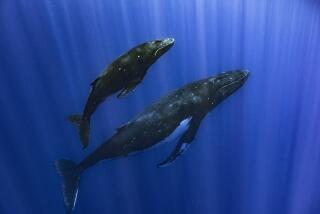Dolphin dies near sonar site
A deep-diving dolphin died on the beach of the Navy’s San Nicolas Island late last month during the final days of naval exercises using a type of sonar that has been linked to fatal injuries of whales and dolphins.
Although researchers have yet to determine a cause of death, a dissection of the northern right whale dolphin’s head revealed blood and other fluid in its ears and ear canals. The same symptoms were found in deep-diving whales that washed ashore in the Canary Islands and the Bahamas after military sonar exercises.
Unlike the mass strandings of whales on the Canary Islands in 2002 and the Bahamas in 2000, only the one dolphin washed ashore Jan. 29 on San Nicolas. That occurred just as the Navy’s 3rd Fleet in San Diego was wrapping up sonar training that has become the focus of a federal court fight and elicited an effort by President Bush to intervene.
Teri Rowles, lead veterinarian with the National Oceanic and Atmospheric Administration, cautioned against jumping to conclusions until a panel of expert radiologists can review magnetic resonance images of the dolphin’s head and federal pathologists can scrutinize various tissues for disease, as well as for air and fat bubbles associated with sonar-related injuries.
“At this point, we cannot rule in or rule out sonar or any other kind of intense noise,” said Rowles, head of the nation’s Marine Mammal Health and Stranding Response Program. “This one is perplexing at this point.”
The dolphin death comes at a delicate time for the Navy, which has appealed a federal court order that imposed extra safeguards to protect whales from possible harm caused by mid-frequency active sonar.
“There is no evidence that any type of naval activities caused or contributed to this dolphin’s death,” said Lt. Mark Walton, a spokesman for the Navy’s 3rd Fleet.
In an appeal filed last week, the Navy stated: “During the last 40 years, there has been no documented incidents of harm, injury or death of marine mammals resulting from exposure to [mid-frequency active] sonar” in Southern California waters.
Lawyers for the Navy argue that a federal court order has no scientific basis to require the Navy to shut down sonar when marine mammals are spotted within 2,200 yards and to avoid areas along the coast and between some of the Channel Islands that are known for their abundance of marine mammals.
These and other court-imposed conditions, Navy officials said, hamper the ability to train sailors to use sonar to detect quiet-running diesel-electric submarines now operated by Iran, China, North Korea and other potentially hostile nations.
The U.S. 9th Circuit Court of Appeals has promised to rule on the Navy’s latest appeal by March 3, so the Navy will have time to petition the U.S. Supreme Court before its next two rounds of sonar testing scheduled to begin in March.
Navy officials first spotted the right whale dolphin washed up on the north end of San Nicolas Island on Jan. 29, as the aircraft carrier Lincoln and its supporting warships were conducting war games to certify that they were prepared to meet threats of all kinds, including submarine attacks, before shipping out to the Persian Gulf in March.
The closest warship using sonar was 62 miles away the previous day and was not part of the exercise, said Capt. Jeff Davis, a Navy spokesman at the Pentagon. The animal first washed ashore alive, and Navy personnel pushed it back into the water several times in an attempt to save it before it died on the beach the next morning. The Navy flew the carcass to Santa Barbara Airport, where curators at the Santa Barbara Museum of Natural History picked it up and performed a necropsy.
The female dolphin, at 6 feet 9 inches long, was a slender 132 pounds but appeared in good shape except for scrapes and scratches from washing up on the rocks, said Michelle Berman, an associate curator at the museum. This type of dolphin, sleek black with no dorsal fin and a white hourglass marking on its belly, had no obvious signs that would indicate a cause of death, she said.
The curators worked all night to perform the necropsy because clues are lost to rapid decomposition. The head was removed and refrigerated, then taken to the nearby Alamo Pintado Equine Medical Center for magnetic resonance imaging.
The initial review, Rowles said, confirmed increased fluid in the ears.
“That could be blood; it could be infection or parasites -- those are the three more common causes of fluid in the ears,” she said. Or it could be trauma related to sonar.
“The lesions that we have seen to date are consistent to what has been found in whales in the Canary Islands and the Bahamas,” Rowles said.
The most telling indications will not come until pathologists can complete microscopic examination of the brain, the ears and other tissues to look for gas or fat bubbles and related hemorrhaging. That’s what showed up in the jaws, ears, brain and kidneys in 10 of 14 beaked whales that died after international naval exercises using mid-frequency sonar.
Scientists in the journal Nature theorized that those deep-diving whales may have panicked and bolted to the surface, causing decompression sickness, similar to the “bends” or air embolisms that can affect human divers. The problem arises when gas bubbles, compressed under the pressure of depth, expand rapidly and tear delicate tissues, like bubbles bursting from a newly popped bottle of champagne.
The microscopic analysis of most tissues should take about a month, Rowles said. It could take as long as a year to examine the ears because the bones must be slowly dissolved in fluid to reveal soft tissues inside.
Rowles expects other lab results within a week that could rule out whether the dolphin was poisoned by a neurotoxin, called domoic acid, produced by certain algae that bloom in California waters.
Joe Cordaro, a wildlife biologist with the National Marine Fisheries Service, said about 20,000 right whale dolphins live in waters off California, Oregon and Washington. Strandings of those animals occur rarely, seldom more than once or twice a year, he said.
Right whale dolphins are social animals, seen gamboling in the waters in pods of hundreds and sometimes thousands. So if the death is linked to sonar, it would be unusual that only one animal washed ashore.
More to Read
Start your day right
Sign up for Essential California for news, features and recommendations from the L.A. Times and beyond in your inbox six days a week.
You may occasionally receive promotional content from the Los Angeles Times.






